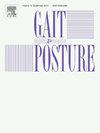Alterations of the center of pressures in the greater trochanter pain syndrome: Evaluation of pelvitrochanteric injuries through dynamic baropodometry
IF 2.2
3区 医学
Q3 NEUROSCIENCES
引用次数: 0
Abstract
Introduction
Greater Trochanteric Pain Syndrome (GTPS) results in lateral hip pain, particularly noticeable during the single-leg stance phase of gait. This study explores the connection between pelvitrochanteric muscle-tendon lesions and changes in the center of pressure (CoP) line in patients diagnosed with GTPS.
Materials and methods
We conducted a study with 104 GTPS patients. Patients were categorized into two groups based on imaging tests: anatomical lesions (functional alteration with structural damage in pelvitrochanteric area tissues) and functional lesions (functional alterations without structural damage in the pelvitrochanteric area). Using a portable pressure platform, we measured plantar pressures and loads, and analyzed the CoP line and its deviation angle both pre- and post-treatment.
Results
Data revealed that patients with anatomical lesions showed significantly greater alterations in both the CoP line and its deviation angle compared to those with functional lesions.
Discussion
These findings indicate that anatomical lesions in gluteal tendons are associated with changes in CoP during gait, which may subsequently affect pelvic tilt in GTPS patients. We propose baropodometry as a tool for biomechanical analysis of pelvis and hip during gait in GTPS, emphasizing the role of the gluteus medius as a pelvic stabilizer during single-leg stance.
Conclusion
GTPS patients showing a deviation in the CoP line during single-leg stance are more likely to have anatomical lesions in gluteal tendons. The use of dynamic baropodometry for biomechanical analysis of the pelvis and hip provides data that aid and improve understanding of GTPS and the development of effective therapeutic strategies.
求助全文
约1分钟内获得全文
求助全文
来源期刊

Gait & posture
医学-神经科学
CiteScore
4.70
自引率
12.50%
发文量
616
审稿时长
6 months
期刊介绍:
Gait & Posture is a vehicle for the publication of up-to-date basic and clinical research on all aspects of locomotion and balance.
The topics covered include: Techniques for the measurement of gait and posture, and the standardization of results presentation; Studies of normal and pathological gait; Treatment of gait and postural abnormalities; Biomechanical and theoretical approaches to gait and posture; Mathematical models of joint and muscle mechanics; Neurological and musculoskeletal function in gait and posture; The evolution of upright posture and bipedal locomotion; Adaptations of carrying loads, walking on uneven surfaces, climbing stairs etc; spinal biomechanics only if they are directly related to gait and/or posture and are of general interest to our readers; The effect of aging and development on gait and posture; Psychological and cultural aspects of gait; Patient education.
 求助内容:
求助内容: 应助结果提醒方式:
应助结果提醒方式:


